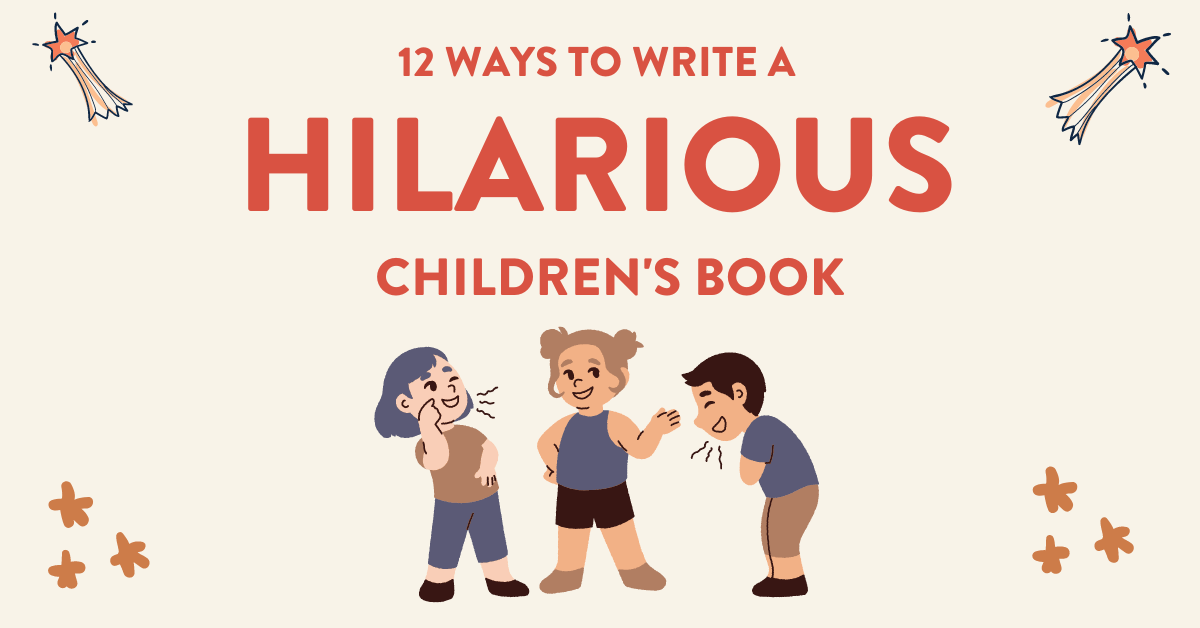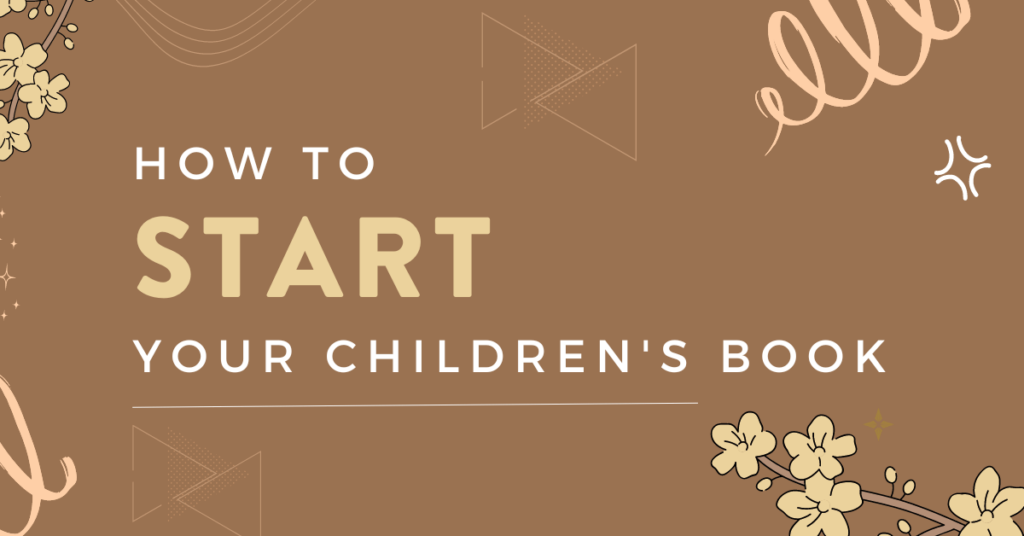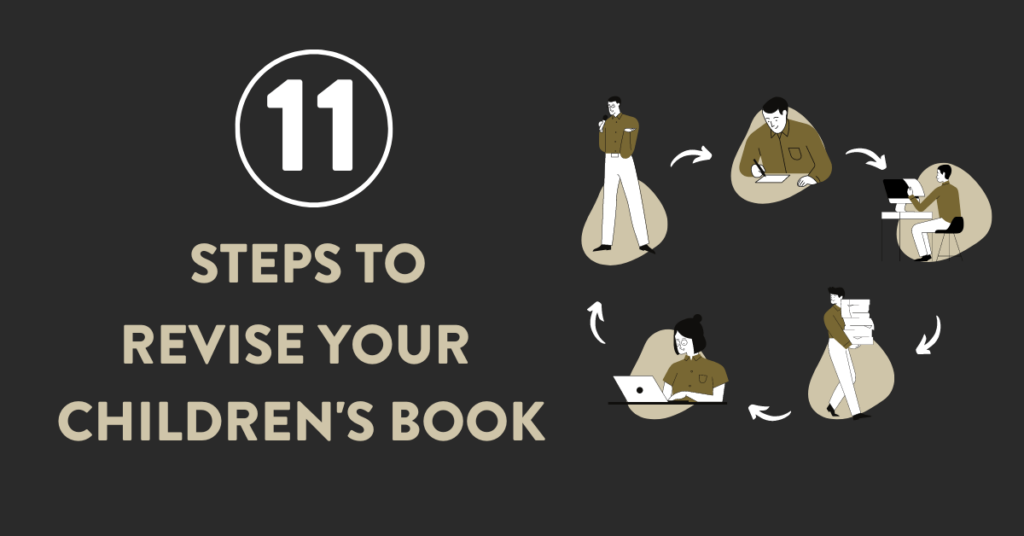
You’ve been there: curled up on the couch, reading a children’s book to a giggling kiddo, and thinking, “Wow, I wish I could write something this funny.”
Good news – you absolutely can! And with a dollop of humor and a dash of creativity, you’ll soon be on your way. Here are ten chuckle-worthy strategies, inspired by everyone from Dr. Seuss to Judith Viorst, to write a funny children’s book that’ll have kids and adults in stitches.
And if you wanted to learn more about how to write a children’s book, you can check out the authoritative children’s book guide.
1. Play With Words
Remember “Fox in Socks” by Dr. Seuss? It’s chock-full of tongue-twisters, and the wordplay is giggle-inducing. It’s always a good idea to play around with rhyme, alliteration, and puns. If done right, it’s a comedic goldmine.
And for kids, who are just getting the lay of the land when it comes to language, it’s fun for them to see all the ways that words can mean multiple things.
Here are three examples of wordplay that you can imitate in your children’s book:
- From “The BFG” by Roald Dahl:
The Big Friendly Giant, or BFG, has his own unique way of speaking, which Roald Dahl termed “gobblefunk.” One of the playful terms he uses is “human beans” instead of “human beings.” This linguistic twist isn’t just a pun; it’s indicative of the BFG’s endearing unfamiliarity with human language. - From “The Amelia Bedelia” series by Peggy Parish:
Amelia Bedelia is famous for taking everything literally. When told to “dress the chicken,” she puts clothes on it! Her misinterpretations, which are essentially puns, bring humor to the series. - From “Pigs Ahoy!” by David McPhail:
The pigs in the story are always in a hurry, which leads to the pun: “Sea you later!” It’s a play on “see you later,” fitting for the oceanic adventure they embark on.
2. Exaggerate, Exaggerate
Think about Judith Viorst’s “Alexander and the Terrible, Horrible, No Good, Very Bad Day”. Alexander doesn’t just have a bad day; it’s the WORST day. The more you exaggerate, the more laughs you’ll get.
Hyperbole appeals to the funny bone because it’s so wild and seemingly untrue. Kids love it even more than adults do.
Here are two more examples:
- “If You Give a Mouse a Cookie” by Laura Numeroff:
The entire premise of this book is built on a chain of exaggerated consequences. If you give a mouse a cookie, he’s going to want milk. If you give him milk, he’ll want a straw. The mouse’s escalating desires, stemming from a single cookie, create a hilarious domino effect of exaggerated outcomes. - “The Day the Crayons Quit” by Drew Daywalt:
Each crayon writes a letter to their owner, Duncan, expressing their grievances. The exaggerations come in the form of their complaints. For instance, the pink crayon is upset about not being used enough and feels that it’s being relegated to only drawing “princess dresses or cupcakes.” The black crayon feels it’s being used only to outline things and is tired of being perceived as a mere accent, demanding to be used for more than just outlines. These anthropomorphic crayons and their larger-than-life emotions make for a delightful read.
3. Adding Humor for Adults
In the world of children’s literature, we often emphasize the importance of captivating our young audience. But there’s another audience in the room, one that’s holding the book, doing the voices, and bringing the story to life: the adult readers.
Whether it’s parents, grandparents, older siblings, or other caregivers, these adult narrators are key players in the reading experience. And guess what? They appreciate a good chuckle just as much as the kiddos do! Let’s explore why infusing humor for both kids and adults is not just a nice-to-have, but a storytelling essential:
- Shared Enjoyment Enhances Bonding:
A book that gets both child and adult laughing fosters a shared experience. This mutual enjoyment can serve as a bonding moment, making reading time a cherished activity for both. When both parties are entertained, the reading ritual becomes something they eagerly look forward to, day after day. - Encourages Multiple Readings:
Let’s face it, adults are more likely to reach for a book that entertains them as well as their young listener. When a story contains humor at multiple levels, it stands a better chance of being plucked off the shelf repeatedly. And we all know the benefits of repeated reading for a child’s language development. - Teaches Kids About Layers in Storytelling:
Children are observant. When they notice adults chuckling at parts of the story they might not fully grasp, it piques their curiosity. They learn that stories can have layers, depths, and hidden treasures. This understanding can shape them into more discerning readers and listeners as they grow.
4. Mismatched Partners
When it comes to crafting memorable children’s tales, some of the most enduring and beloved are those that center around unlikely friendships.
Think of the tortoise and the hare, the city mouse and the country mouse, or even a hobbit and a wizard!
There’s inherent charm and wit in bringing together characters from vastly different worlds or with contrasting personalities.
- Play with Expectations:
The juxtaposition of characters with contrasting backgrounds or personalities sets the stage for comedic gold. A sloth paired with a hyperactive squirrel? The slow versus fast dynamic will naturally lead to humorous scenarios. Play with readers’ expectations of how these characters should behave based on their stereotypes, and then flip those expectations on their head. - Create Complementary Conflicts:
Your characters, due to their differences, will naturally have conflicting views or approaches to situations. Perhaps a tech-savvy robot and a nature-loving fairy are forced to plan a party together. The robot wants everything automated, while the fairy insists on handcrafted decor. These complementary conflicts create organic moments of humor as each tries to navigate the other’s world. - Dialogue Delights:
Through dialogue, highlight the differences in their backgrounds, knowledge, and worldviews. Maybe one character uses old-fashioned language while the other spouts modern slang. This contrast can lead to funny misunderstandings, playful corrections, and comical teaching moments.
5. Visual Gags
Sure, words can be funny, but images can be too! Nothing like a good illustration to tickle the funny bone and get the kids chuckling.
An illustration of a cat wearing oversized glasses, reading a newspaper upside down, or a dog attempting to blend in with flamingos at a ballet class—these scenarios can elicit peals of laughter.
The illustrator’s role is to dream up and capture such eccentric moments that might not be detailed in the text.
- Adding Layers to the Story:
Visual gags can add subplots or side stories not explicitly mentioned in the main narrative. For example, if the story is about two characters on a journey, the background might depict a squirrel’s comedic attempts to open a walnut in various, increasingly desperate ways across several pages. - Expressive Characters:
Sometimes, it isn’t about what’s happening but how the characters react. The illustrator can heighten humor by exaggerating characters’ expressions—rolling eyes, over-the-top shocked faces, or even just a well-placed raised eyebrow. It’s these reactions that often make readers pause, chuckle, and eagerly turn the page. - Play with Perspectives:
An unusual point of view can be a source of humor. Imagine a bird’s-eye view of a picnic with ants sneakily stealing crumbs, or a worm’s-eye view of a dance-off between garden critters. The illustrator’s choice of perspective can transform an ordinary scene into something hilariously unexpected.
While the illustrator is the visual genius, collaborating closely with the author ensures that the illustrations enhance the story’s humor rather than overshadow or conflict with it. It’s a delicate dance of words and images, where both parties respect and amplify each other’s creative strengths.
6. Mischievous Antics
Kids love mischief. They love doing it and they love reading about it.
That’s why the next way you should create humor in your book is to use some mischievous antics. Here’s a closer look at how illustrators use mischief to craft comedy:
- 1. A Story Within a Story:
While the main narrative unfolds front and center, the illustrator can weave in a secondary storyline brimming with mischievous antics.- Example: In a book about a school trip to a zoo, while children learn about animals, a curious monkey could be depicted secretly “borrowing” items from the children and the zookeepers, amassing a collection of hats, snacks, and toys by the story’s end.
- 2. Reverse Expectations
Mischievous illustrations can showcase unexpected interactions between characters. This can be a gentle poke at familiar stereotypes, twisting them in a humorous way.- Example: Imagine a scene at a farm where instead of the cat chasing the mouse, the mouse is giving the cat a playful ride, with both characters enjoying the reversal of roles.
- 3. Subtle Background Details:
Sometimes, the most minor details can incite the biggest laughs. Tiny, easy-to-miss illustrations can invite readers to scour the page and reward their diligence with a smile.- Example: In a book about a bustling city, a pigeon might be seen sporting sunglasses and sipping from a discarded coffee cup, mimicking the busy urbanites around it.
- 4. Dynamic Reactions:
Mischievous antics aren’t just about the act itself but also about how other characters react to it. An exaggerated, humorous response can amplify the comedy of the mischief.- Example: If a sneaky character paints polka dots on a sleeping lion, the subsequent illustrations might depict animals reacting with laughter, shock, or even taking selfies with the unsuspecting, newly-decorated lion.
7. The Rule of Threes
In comedy, the “Rule of Threes” is a timeless principle that hinges on setting up a pattern with two items and then delivering an unexpected twist with the third.
It’s a rhythm that’s inherently satisfying and funny, and its application isn’t restricted to just written or spoken content. In children’s picture books, the Rule of Threes can elevate the humor. Let’s delve deeper:
Example: In an illustrated sequence, we might see a child trying:
- to catch a butterfly with a net
- followed by an attempt to catch a bird.
- Both times, the child might narrowly miss. The third time, the child might accidentally “catch” themselves, and end up standing inside their own net with a sheepish look on their face.
Comedians do the rule of threes in their standup sets, and when you’re writing for adults, the last thing in a series of three is often a joke. It’s a perfect example of what’s often called “comedic timing.”
For young readers, the Rule of Threes also serves an educational purpose. It teaches pattern recognition, prediction, and the joy of unexpected outcomes. It encourages children to think ahead, wonder, and then revel in the surprise.
8. “Meta” Humor
Meta humor, a self-reflective form of comedy that winks at the reader, has been a hit in various entertainment mediums from movies to sitcoms.
But when it comes to children’s books, it offers a unique playground, breaking the fourth wall and directly engaging young readers.
A good way to use this technique is to have the characters address the reader directly. By addressing them directly, characters acknowledge the “reality” of being in a book and playfully invite readers to join in on the fun.
Example: “The Monster at the End of This Book” features the lovable Elmo from Sesame Street who spends the entire book pleading with readers not to turn the page, for fear of encountering a monster. The twist, of course, is delightfully ironic: the monster is … the child! Yep, the child reading the book.
9. Funny Endings
Ah, the ending of a book – the grand finale, the climax, the moment every reader is holding their breath for.
But what if, instead of a profound lesson or a touching resolution, you threw in a curveball that left your young reader in fits of giggles? Welcome to the joy of hilarious endings in children’s books!
- Subvert Expectations: Imagine a story of a dragon who’s on a quest to find the fiercest creature. After meeting knights, ogres, and witches, the dragon discovers the fiercest creature is… a tiny mouse with a penchant for cheese. The unexpected juxtaposition here works wonders!
- Throw a Curveball: In a tale where woodland animals are terrified of a mysterious creature lurking in the forest, the reveal could be a fluffy, oversized rabbit who’s just looking for a dance party.
- Invert the stereotypes: A story about a pirate who isn’t out for treasure, but instead, is on a quest to find the perfect hat for his parrot? Now that’s an unexpected swashbuckling adventure!
Sometimes, the more outlandish and absurd the ending, the better. This is especially true for kids with a zany sense of humor who appreciate over-the-top scenarios.
10. Quirky Sidekicks
Think about how many movies there are with a sidekick friend who is the comedic relief. What works in movies also works in children’s books!
Have a sidekick constantly cracking jokes and you’ll have your child readers in stitches.
Main characters often carry the weight of the plot, which means they can sometimes be predictable. In contrast, quirky side characters are not bound by these narrative responsibilities, allowing them to be spontaneous, often hilariously so.
- Example: Think of the Cheshire Cat in “Alice in Wonderland” by Lewis Carroll. His enigmatic demeanor and puzzling remarks not only add mystery but also inject humor in the most unexpected places.
- Example: The minions in the “Despicable Me” series, while not from a book, are perfect examples. Their nonsensical babble and antics offer consistent comic relief amidst the main plot.
Side characters with eccentricities can be your comedic secret weapon.
11. Making Grown-Ups Goofy
Isn’t it a hoot when the so-called ‘grown-ups’ in our tales don’t have it all figured out?
Let’s face it, kids LOVE seeing adults in silly situations, mainly because it defies their everyday experiences. In the real world, adults are the ones in control, setting the rules.
So when a children’s book flips this dynamic and showcases adults making errors or looking downright silly, it’s bound to get giggles.
Why Adults Making Mistakes is Comedy Gold
- Relatability: Every kid has watched an adult mess up, whether it’s misplacing car keys or spilling coffee. By magnifying these moments in a story, children feel a secret camaraderie: “Hey, my parents do that too!”
- Power Dynamics: It’s empowering for children to see themselves in a more knowledgeable or competent role, even if only in a story.
Crafting Comical Adult Characters
- The Overconfident Oaf: Think of an adult who thinks they know it all but gets it hilariously wrong. Like a dad confidently trying to set up a tent and ending up with something resembling a lopsided jellyfish.
- The Clueless Newbie: The adult who is venturing into a child’s domain and is utterly out of their depth. Picture a grandmother trying to play a video game and accidentally deleting a crucial saved game.
- Literal-Minded Lunatic: This character takes everything literally. If told to “keep an eye on the pie,” they might sit staring intently at it, while it’s clearly burning.
Playing with Child-Adult Role Reversals
Allow the children in your story to become the ‘voice of reason’. This is not just hilarious but also boosts the child reader’s confidence. Imagine a scenario where a mother is panicking because she can’t find her glasses, only for her young daughter to point out they’re on her head.
Now, while it’s fun to poke fun at adults, ensure that while the grown-ups may be goofy or mistake-prone, they’re still lovable and well-intentioned.
In the end, using adults as comedic devices in children’s books not only delivers laughs but subtly reinforces the idea that everyone, regardless of age, makes mistakes.
12. “Fish Out of Water” Technique
When kids step outside their comfort zones into situations they’re not familiar with, there’s not only an opportunity for growth but also for comedy. The “Fish Out of Water” scenario is even more relatable and hilarious when it involves children facing amusingly overwhelming odds.
Begin with a relatable setting for the child – their bedroom, a school, a local park. Now, transplant this child into an entirely unfamiliar setting.
Perhaps it’s a knight-in-training suddenly placed in a modern classroom. Or a city kid experiencing country life with comically misunderstood farm chores.
- Example: A child who’s only seen birds in books might try to “recharge” a tired pigeon in the city by plugging it in.
- Example: In a story about a modern kid in a fairy-tale world, a troll might become hilariously frustrated when the child tries paying a bridge toll with a credit card.
- Example: If our protagonist is a space kid on Earth for the first time, the illustrations might show them trying to wear a cat as a hat or using an umbrella upside-down to “catch” rain.



